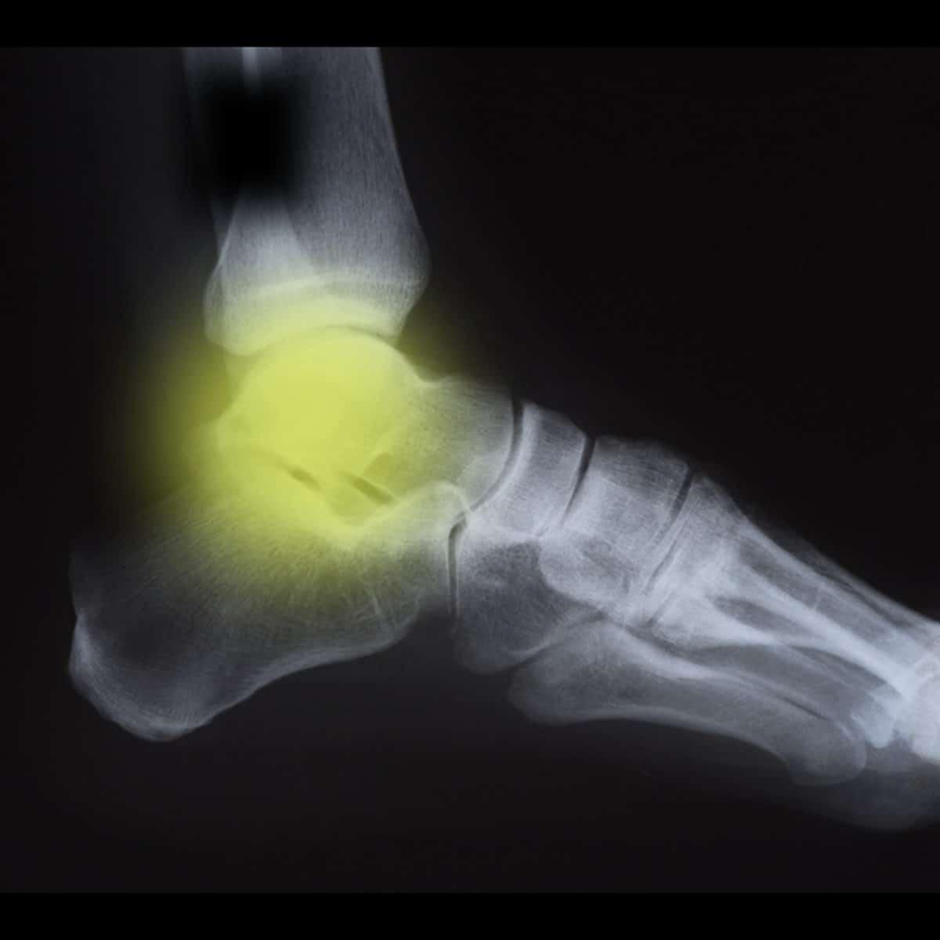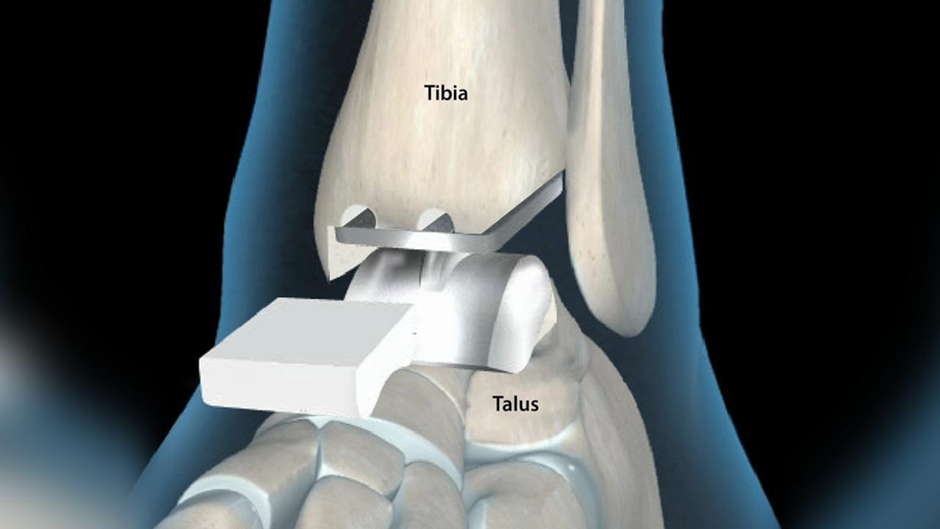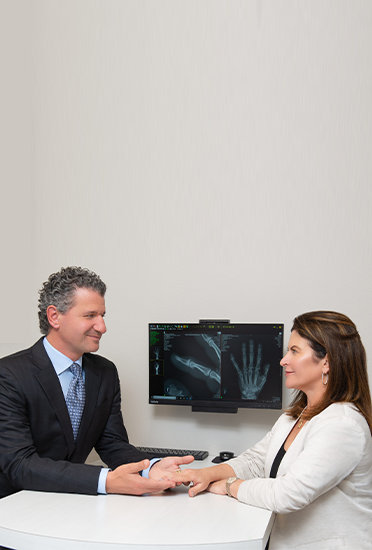Total Ankle Replacement
What is Total Ankle Replacement Surgery?

Also known as ankle arthroplasty, total ankle replacement is a surgical procedure for patients diagnosed with arthritis of the ankle. Total ankle replacement surgery can relieve pain, maintain motion within the arthritic ankle joint, and significantly improve your quality of life. Apart from that, ankle replacement surgery acts as a perfect alternative to ankle fusion (arthrodesis).
Your orthopedic surgeon removes the ankle joint and replaces it with an artificial ankle during the total ankle replacement surgery. This artificial implant is usually made of plastic and metal. The main idea behind ankle replacement is to use artificial implants to reduce pain and preserve ankle motion. In simple terms, this medical procedure aims at relieving your pain and promoting better function of your ankle when performing various activities.
Who Needs Ankle Replacement Surgery?
Generally, total ankle replacement surgery is highly recommended for patients older than 60. These are patients who do not participate in high-impact activities and are not obese or overweight.
Causes of Total Ankle Replacement
Many causes are attributed to ankle replacement surgery. The common ones include severe arthritis in the ankle. The main forms of arthritis of the ankle are: –
Osteoarthritis:
This form of arthritis of the ankle refers to the “wear and tear” process in older adults
Rheumatoid arthritis:
This type of ankle arthritis involves a system-wide auto-immune disease that affects the ankle joints

Post-Traumatic Arthritis:
This is caused by your past injuries to the ankle joint.
In case of mild or moderate ankle arthritis, your doctor will recommend other treatment options such as wearing special shoes, taking pain medicines, using foot inserts, going for physical therapy, and taking corticosteroid injections. However, total ankle replacement surgery may come in handy if you have severe symptoms and signs that interfere with your normal lifestyle.
Symptoms of Arthritis
Several symptoms contribute to why your healthcare provider may suggest ankle arthroplasty. Some of these symptoms of total ankle replacement may include the following:
- Advanced stages of ankle arthritis, especially severe cases of osteoarthritis
- Chronic ankle pain due to injuries sustained in sports or trauma due to a fall or an accident
- Limited mobility of your ankle
- Loss of range of motion in your ankle
- Extreme weakness in the foot and ankle
- Multiple ankle sprains during childhood
- Severe ankle fractures that fail to heal properly
Total Ankle Replacement Diagnosis

Suppose you suspect that your ankle is injured, has limited mobility, is experiencing chronic pain, or is affected by arthritis. In that case, your next step should be to seek medical advice from professional orthopedic doctors. Your doctor will perform a series of tests to establish the real cause of discomfort in your ankle before choosing the most appropriate treatment option. Some of the diagnostic tests may involve these imaging techniques:
- X-ray: The doctor will perform an X-ray test to show the structure of bones within the affected ankle. The images produced by the X-ray machine will provide information about the condition of your injured ankle. From these images, your healthcare provider will decide whether to perform total ankle replacement surgery or use nonsurgical treatment to relieve pain.
- MRI: On the other hand, your doctor may use MRI to analyze the condition of your ankle. The MRI will provide detailed images of the internal structure of your ankle. From this information, your doctor will know the type of treatment that your ankle needs. In case of severe cases of ankle arthritis, the doctor may use the MRI images to act as a guide during the total ankle replacement procedure.
Total Ankle Replacement Treatment

After you have established a proper diagnosis, your doctor will suggest nonsurgical or surgical treatment options depending on the severity of your condition. The non-surgical option will come first, as encouraged by your doctors.
- Nonsurgical Treatment: During the treatment process, your healthcare provider will recommend using anti-inflammatory medicines, cortisone injections, physiotherapy, and the use of a cane or braces.
- Surgical Treatment: In case non-surgical treatment fails, surgical treatment may provide the ultimate solution. Your doctor will certainly consider your circumstances before allowing you to undergo total ankle replacement surgery.
Risks of Ankle Replacement Surgery
Surgical procedures come with their own risks and possible complications. The same case applies to ankle replacement surgery and ankle cartilage repair. Often, these risk factors are associated with infection, damage to the blood vessels, anaesthesia, blood clots, and bleeding.
Post-Operative Care (Recovery) of Total Ankle Replacement

Recovery from total ankle replacement may take between six and 12 months. During this ankle replacement recovery time, you will have to take the following post-operative care steps seriously:
- Wear a splint for some weeks
- Use crutches for a couple of days or weeks
- Follow your doctor’s instructions on how to move your feet
- Take enough rest when it is appropriate to do so
- Elevate your leg during the first weeks after ankle surgery
- Keep all your medical follow-up appointments as instructed by your doctor
- If possible, go for physical therapy to help maintain your range of motion and strength of your legs.
Find the Best Total Ankle Replacement Center near You in Sarasota, Florida
Are you looking for the most reliable and professional total ankle replacement surgery? Dr. Christopher L. Dillingham specializes in both foot and ankle surgery. Dr. Dillingham is specifically trained in complex ankle arthroplasty (ankle replacement) using state-of-the-art equipment and exceptional surgical techniques to help you get back to your normal lifestyle.
A simple Google search of “ankle replacement surgeons near me” will certainly direct you to Dr. Christopher L. Dillingham, who specializes in performing the technically demanding ankle replacement procedure, arthritis surgery, and ankle replacement surgery. Schedule your appointment today with one of our doctors through:
Phone: 941.378.5100
Or
Fax:941.378.2805
Final Thought
Total ankle replacement surgery or arthroplasty ankle helps treat the arthritis of the ankle. This surgical technique helps reduce pain, improve overall mobility and increase joint stability. Your orthopedic surgeon will only recommend total ankle replacement when other treatments fail to relieve ankle arthritis symptoms. Visit Sforzo | Dillingham | Stewart Orthopedics + Sports Medicine to learn more about total ankle replacement details, benefits, recovery, and when to visit the doctor.

























